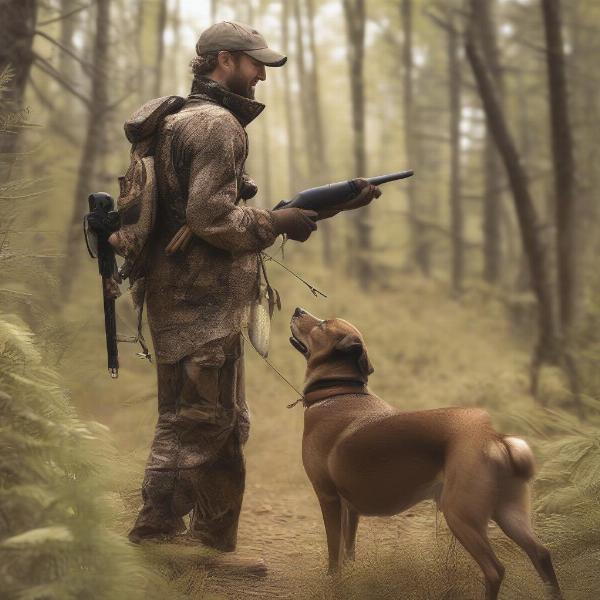Deer tracking dogs possess an incredible ability to follow the scent of a deer, making them invaluable partners for hunters and wildlife researchers. Whether you’re a seasoned hunter or simply fascinated by these remarkable canines, this comprehensive guide will delve into the world of deer tracking dogs, covering everything from breed selection and training to their vital role in wildlife management.
Choosing the Right Deer Tracking Dog
Selecting the right breed is crucial for successful deer tracking. Certain breeds are naturally predisposed to this task, possessing a heightened sense of smell and an innate desire to track. Popular choices include Bavarian Mountain Hounds, Hanover Hounds, Plott Hounds, and Drahthaars. These breeds are known for their stamina, focus, and ability to navigate challenging terrains. While other breeds can be trained to track, these specialized breeds often exhibit a natural aptitude for the task. Consider your hunting style and environment when making your choice. Are you tracking in dense forests or open fields? Do you require a dog that can also retrieve? Answering these questions will help narrow down your options. For more in-depth information on suitable breeds, see our article on best dog for deer tracking.
Training Your Deer Tracking Dog
Training a deer tracking dog requires patience, consistency, and a positive approach. Begin with basic obedience training to establish a strong foundation. Once your dog understands basic commands, introduce them to the scent of deer. This can be done using deer hide, antlers, or even commercially available deer scents. Start with short, easy trails and gradually increase the complexity and length as your dog progresses. Positive reinforcement with rewards and praise is crucial throughout the training process. Remember, each dog learns at its own pace, so be patient and adapt your training methods as needed. Consistency is key to developing a reliable and skilled deer tracking companion. Are you looking for tips on effective training methods? Visit our article on good tracking dogs for expert advice.
The Importance of Deer Tracking Dogs in Wildlife Management
Deer tracking dogs play a vital role in wildlife management, assisting researchers and conservationists in monitoring deer populations and studying their behavior. They can locate injured or diseased deer, allowing for timely intervention and preventing the spread of disease. Their ability to track deer through various terrains makes them invaluable for collecting data on deer movement and habitat utilization. This information helps inform conservation strategies and ensure the long-term health of deer populations.
Equipment for Deer Tracking Dogs
A well-equipped deer tracking dog is a safer and more effective partner. Essential gear includes a sturdy tracking harness, a GPS tracker for safety, and a first-aid kit for any minor injuries encountered during the track. Consider investing in protective boots for your dog, especially in rough terrain. For a comprehensive guide on essential equipment, check out our article on good deer tracking dogs.
The Ethics of Using Deer Tracking Dogs
 Ethical Considerations for Using Deer Tracking Dogs
Ethical Considerations for Using Deer Tracking Dogs
Using deer tracking dogs ethically and responsibly is paramount. Always adhere to local hunting regulations and respect wildlife. Avoid tracking during sensitive periods, such as fawning season, and prioritize the well-being of your dog. Ensure your dog is properly trained and equipped for the task. Responsible hunting practices not only ensure the sustainability of deer populations but also uphold the ethical standards of hunting with dogs. For a deeper understanding of ethical considerations, visit our article on best tracking dogs for deer.
Conclusion
Deer tracking dogs are extraordinary companions, combining their natural instincts with dedicated training to become invaluable partners in hunting and wildlife management. By choosing the right breed, implementing effective training methods, and prioritizing ethical practices, you can foster a strong bond with your deer tracking dog and contribute to responsible wildlife conservation.
FAQ
- What are the best breeds for deer tracking? Bavarian Mountain Hounds, Hanover Hounds, Plott Hounds, and Drahthaars are among the top choices.
- How do I start training my dog for deer tracking? Begin with basic obedience and gradually introduce deer scent, starting with short, easy trails.
- What equipment do I need for my deer tracking dog? A tracking harness, GPS tracker, first-aid kit, and protective boots are essential.
- What are the ethical considerations when using deer tracking dogs? Adhere to hunting regulations, respect wildlife, and prioritize your dog’s well-being.
- How do deer tracking dogs contribute to wildlife management? They assist researchers in monitoring populations, studying behavior, and locating injured or diseased deer.
- Where can I find deer tracking dogs for sale? You can explore reputable breeders specializing in these breeds. Check out our article on deer tracking dogs for sale for more information.
- What makes a good deer tracking dog? A combination of strong scenting ability, stamina, focus, and trainability.
ILM Dog is your trusted source for comprehensive information on dog care and breeding. We offer expert advice on various aspects, including breed selection, health, training, nutrition, and grooming. Whether you’re a seasoned dog owner or just starting your journey, our resources can help you provide the best possible care for your canine companion. Contact us for personalized guidance and support. Email: [email protected] Phone: +44 20-3965-8624 Visit us at ILM Dog for more valuable insights into the world of dogs.